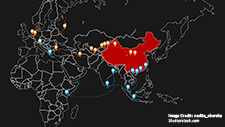New Silk Road
More than two millennia ago, two main trade routes linked ancient China with other nations in the world–the Silk Road and the Maritime Silk Road. Since these ancient times, the Silk Road and the Maritime Silk Road have played an important role in the economic and cultural exchanges between eastern and western Eurasia. Today, China stands as the world’s second biggest economic power, the biggest industrialized country, and the biggest export country with the highest foreign-exchange reserves. In this new context, China is reviving the dream and spirit of the ancient Silk Road by exploring new approaches to international cooperation and shaping frameworks for international and regional economic collaboration.
Related Publications
-
Japan’s Energy Security in the Persian Gulf: Caught Between New and Old Challenges
The goal of this paper is to investigate the evolution of Japan’s energy strategy in the Persian Gulf and understand how intra-Asian competition for business opportunities in the region can […]
-
ISDP Annual Report 2023
ISDP’s Annual Report for the year 2023. We look back on 2023, a year in which tensions and conflicts captured the strategic space in ISDP’s focus areas, making headlines around […]
-
IN DEFENSE OF THE LIBERAL INTERNATIONAL ORDER
In recent years, the geopolitical fight for global economic, diplomatic, and institutional control has acutely intensified, accentuating the crisis in the existing post-World War II Liberal International Order (LIO), championed […]
-
China in Eurasia: Revisiting BRI amidst the Russia-Ukraine Crisis
This paper discusses China’s trade and connectivity plans under the Belt and Road Initiative (BRI) in the Eurasian region and the impact of the Russian invasion of Ukraine on Chinese […]
-
Understanding North Korea’s Resilience through Economy, Laws and Governance: a review of introductory sources and essential monographs
This article reviews contributions that may help researchers re-evaluate the question of the North Korea’s remarkable resilience in spite of its undeniable economic failure, a seemingly obscure legal system, and […]




